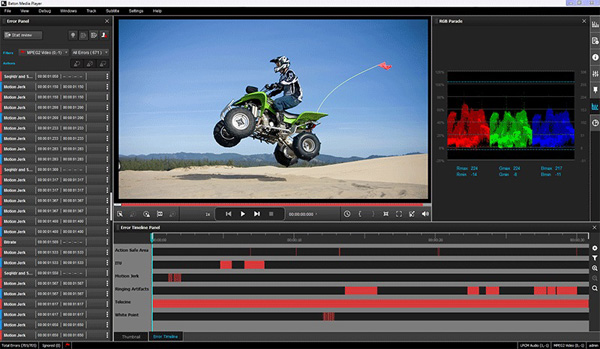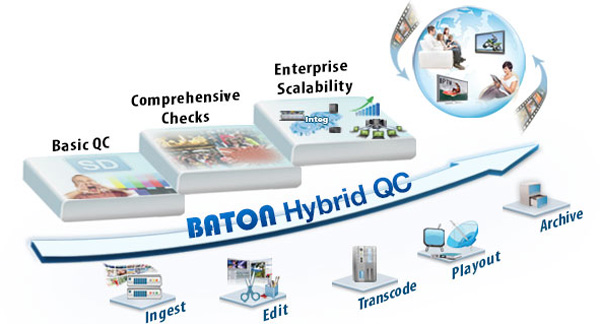Interra's Software-based QC/Monitoring Keeps OTT Delivery in Check

For many years, operators in global broadcast, cable, telco, satellite and IPTV markets have relied on rigid, non-customizable hardware infrastructure for quality control (QC) and monitoring. But, as operators expand into the OTT environment, many of them see value in end-to-end software-based systems. Switching to a software-based environment means operators can unify their previously separate infrastructures for OTT and traditional pay-TV services, consolidating operations and making each one more efficient, reducing costs and differentiating themselves from the competition by improving the quality of experience (QoE) and quality of service (QoS) they deliver to end users.
Anupama Anantharaman, director of sales and product marketing at Interra Systems, described new challenges that have emerged for pay-TV operators due to the increase in OTT video consumption, and some öf the ways that Interra handles them.
ABR Variants
“OTT video content is distributed via adaptive bit-rate (ABR) encoding and streaming. One of the difficulties operators face in the OTT environment compared with traditional broadcast is the requirement to create multiple versions, called variants, of each piece of video content,” she said. “Each variant is encoded at different bitrates and profiles to ensure that end users receive the best possible quality video on all screens, at any time. Having multiple versions of each piece of content means operators have more to manage from a QC and monitoring perspective. When problems are not addressed during one stage of the OTT workflow, they carry through the delivery chain and result in poor QoE.

"Interra Systems addresses this issue by automating QC and monitoring during each stage of the OTT chain, from content preparation to archive, with the option to manually intervene when necessary. Automating these tasks using one system enables operators to keep up with the large number of video files coming from various sources compared with manual approaches that are time-consuming, expensive and may not be reliable."
By using BATON QC platform, operators can check the format, presence of video artifacts and baseband issues with a high level of accuracy and reliability, with minimal false positives. BATON is capable of checking a large volume of content in an offline, file-based environment, which is an approach that works well with OTT.
Life After QC
After video files pass through QC, monitoring is important at several different levels. Interra Systems’ ORION-OTT is one of the first software-based OTT monitoring applications for checking content integrity and related network performance of ABR content for multiscreen service delivery. ORION-OTT is an end-to-end solution with a software-defined architecture that is easy to deploy on cloud-based infrastructure, which is perfect for the fast-paced OTT world.

ORION-OTT gives operators a reliable method for checking inconsistencies related to ABR package compliance, manifest/playlist syntax, download errors, content quality and other factors. The system can also be used for origin server load testing. A real-time graphical representation of content delivery quality is shown, with different monitoring views for assets and services under testing. Service providers can drill down from a high level overview to specific details. Reports and data analytics allow operators to identify trends and maintain service quality for both live and VOD content on all screens.
By carrying out thorough checks for video quality - blockiness, black frames, freeze frames - conformance with industry and government regulations, ORION-OTT makes sure that the content within the ABR package meets, or even exceeds, quality expectations depending on the user's settings.
Subscriber Experience
After the distribution stage, being able to monitor the subscriber experience in real time and collecting user data from client devices is also important. In this way, operators can understand recurrent issues, what causes them and the impact of anomalies on the customer base. These data include startup time, buffering ratio, number of stalls and play failures.
DRM is another challenge that operators face when distributing OTT content. After content is validated with QC checks, it is ready for distribution and must be encrypted with one or more DRM systems for content protection. Interra Systems’ monitoring system is unusual in that it supports all most-used DRMs so that operators can extract QoE information. Without decryption operators would be limited to only viewing QoS statistics.

Furthermore, the types of standards and video compression formats used in the OTT environment are different than in linear delivery, which can be a stumbling block for operators in terms of understanding all of the relevant types used and keeping pace with changes.
OTT Evolution
Since Interra Systems’ QC and monitoring products are software-based, operators can update their systems more easliy for new video formats, protocols and device types, including HEVC for compression and MPEG-DASH and Microsoft Smooth Streaming distribution standards. Ultimately, this helps them maintain their intention of delivering high-quality video to any device at the lowest possible bandwidth.
The OTT environment is still constantly evolving. Beyond deploying a different workflow and new systems, it requires pay-TV operators to change the way they think about QC and monitoring operations. Rigid, hardware-based systems and manual methods don’t enable operators to be agile or reliable in ensuring a superior QoE and QOS. With OTT content, there is increased complexity and chance for error. Having an end-to-end, software-based system for checking content quality and monitoring content at every point in the workflow is important. www.interrasystems.com




